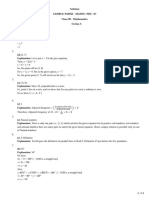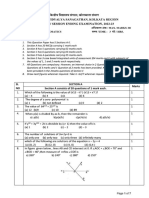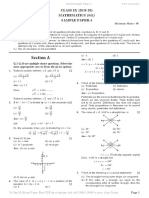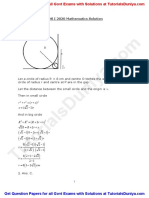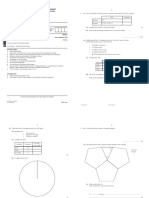Solution
MATHS
Class 09 - Mathematics
Section A
1. (a) 4
Explanation:
x 2x
2 3 81
( ) ( ) =
3 2 16
−x 2x 4
3 3 3
( ) ( ) = ( )
2 2 4
2
−x+2x
3 3 4
⇒ ( ) = ( )
2 2
x
3 3 4
⇒ ( ) = ( )
2 2
Comparing, we get
x=4
2.
–
(c) 5√5
Explanation:
−− –
15√15 is divided by 3√3
15√15
=
3√3
5√3√5
=
√3
–
= 5√5
3. (a) 6 units
Explanation:
Perpendicular distance of a point from x-axis is y-ordinate of the given point is (-3, - 6).
Distance = 6 unit
4.
(b) on x-axis
Explanation:
Every point on the x-axis is of the form (a, 0). This means abscissa can be any real number but ordinate is always 0.
5.
(d) y = 2x + 1
Explanation:
The points on the line are (–1, –6), (0, –4), (1, –2), (2, 0). By inspection, you can see that y = 2x – 4 is the equation
corresponding to the given graph (line).
6.
(c) A is true but R is false.
Explanation:
Every linear equation has degree 1.
2x + 5 = 0 and 3x + y = 5 are linear equations. So, both have degree 1.
7. (a) 125°, 125°, 35°
Explanation:
We are given, AB || CD and AB || EF
So, CD || EF
⇒ 55° + x = 180° (co-interior angles)
⇒ x = 180° - 55° = 125°
1 / 10
� Also, AB || CD, so
⇒ x = y = 125° (corresponding angles)
Now, as AB || EF
∠AEF + ∠ EAB = 180° (co-interior angles)
⇒ z + 55°+ 90° = 180°
⇒ z = 180°-145° = 35°
8. (a) 36°
Explanation:
Let x and (90o – x) be two complimentary angles
According to question,
2x = 3 (90o – x)
2x = 270o – 3x
x = 54o
The angles are:
54o and 90o – 54o = 36o
Thus, smallest angle is 36o
9.
(d) 4 cm
Explanation:
In a triangle, if two of its angles are equal then the sides opposite to equal angles are also equal.
In △PQR, ∠ R = ∠ P
⇒ QR (side opposite to ∠ P) = PQ (side opposite to ∠ R)
Given that, QR = 4 cm
⇒ PQ = 4 cm
10.
(b) BA >BD
Explanation:
Since,∠BAC is bisected by AD, then ∠BAD is less than ∠ABC ,hence the side opposite ∠ABC , i.e. BA is greater than the
side opposite to ∠BAD i.e.BD
11.
(c) 24 cm
Explanation:
√3 –
Area of equilateral triangle = 4
2
(Side) = 16√3
2
⇒ (Side) = 64
⇒ Side = 8 cm
Perimeter of equilateral triangle = 3 × side
= 3 × 8 = 24 cm
12. (a) 5.196 cm 2
Explanation:
√3 2
Area of equilateral triangle = 4
(Side)
√3 – –
= 4
× 2√3 × 2√3
–
= 3√3
= 3 x 1.732 = 5.196 sq. cm
13.
(d) 2
Explanation:
2 / 10
� frequency of the class
Adjusted frequency = ( ) × 5
width of the class
Therefore, Adjusted frequency of 25 - 45 = 8
20
× 5 = 2
14.
(b) 21
Explanation:
Add the values corresponding to the height of the bar from 60 to 100
10 + 5 + 3 + 3 = 21
15.
(d) A is false but R is true.
Explanation:
6+6+6 18
s= 2
=
2
= 9 cm
−−−−−−−−−−−−−−−− −
Area = √9(9 − 6)(9 − 6)(9 − 6)
= √9 × 3 × 3 × 3 = 9√3 cm2
−−−−−−−−−−− –
16. (a) A
Explanation:
A triangle can have two or even all three acute angles (in case of an equilateral triangle) but it cannot have two right angles or
two obtuse angles as the sum of the interior angles of a triangle is 180o and two right angles or two obtuse angles would sum
up to 180o or more leaving the no space for the third angle.
17. (a) irrational
Explanation:
– −−−−−−−−−−−−−−−
√80 = √(2 × 2 × 2 × 2 × 5)
–
= 2 × 2 √5
–
= 4√5 which is an irrational number
18. (a) True
Explanation:
True.
Substituting x = 0 and y = 3 in the equation, we get
0 + 4(3) = 12
Thus, (0, 3) does satisfies the equation.
19. (a) Both A and R are true and R is the correct explanation of A.
Explanation:
(-3, 5) and (5, -3) are different points as (-3, 5) lies in II quadrant and (5, -3) lies in IV quadrant. Also, abscissas and ordinates
of both points are different.
20.
(c) Through a given point, only one straight line can be drawn.
Explanation:
This statement is false because we can draw infinitely many straight lines through a given point.
Section B
21. We are given that,
∠ 2 = ∠ 4 [Vertically opposite angles]
and, ∠ 4 = ∠ 6 [Alternate angles]
∠2 = ∠4 = ∠6
Now, ∠ 2 = ∠ 4
⇒ 2x + 30 = x + 2y
⇒ 2x - x - 2 y + 30 = 0
⇒ x - 2y + 30 = 0 ...(i)
3 / 10
� and, ∠ 4 = ∠ 6
(x + 2y) = (3y +10) ...(ii)
Subtracting (ii) from (i), we have,
(x - 2y + 30) - (x - y - 10) = 0
⇒ -y + 40 = 0
⇒ y = 40
Putting y = 40 in (ii), we get = 50
∠ 4 = (x + 2y)° = (50 + 2 × 40)° = 130°
But, ∠ 4 + ∠ 5 = 180° [consecutive angles]
130° + ∠ 5 = 180°
⇒ ∠ 5 = 50°
22. 90
Explanation:
Given: In a given figure, AB divides ∠ DAC in the ratio 1 : 3 and AB = DB.
To find : x.
Solution: Let the ratio be z and 3z.
∠ CAE = 108o
Also ∠ DAC + ∠ CAE = 180o (Linear pair)
⇒ ∠ DAC + 108o = 180o
⇒ ∠ DAC = 180o - 108o
⇒ ∠ DAC = 72o
⇒ z + 3z = 72o [∠ DAC = z + 3z]
⇒ 4z = 72o
⇒ z = 18o
⇒ ∠ BAC = 3z = 3 × 18o = 54o
⇒ ∠ BDA = ∠ BAD = z (∵ AB = DB)
⇒ ∠ ADC = ∠ BAD = 18o
Now, In △ADC,
∠ ADC + ∠ ACD + ∠ CAD = 180o [angle sum property for triangle]
⇒ 18o + x + 4z = 180o
⇒ x + 18o+ 72o = 180o
⇒ x + 90o = 180
⇒ x = 90o
23. 20
Explanation:
– –
(5 − √5)(5 + √5)
According to the formula a2 - b2 = (a + b)(a - b) = (5)2 - (√5)
– 2
So we get
= 25 - 5
= 20
4 / 10
� – –
24. Let y = 5
and its denominator = √3 − √5
√3− √5
– – – –
Here, the conjugate of denominator (√3 − √5) is (√3 + √5).
√3+ √5
y =
5
× [by rationalising)
√3− √5 √3+ √5
[∵ (a-b)(a+b)=a2 - b2]
5( √3+ √5)
=
2 2
( √3) −( √5)
5( √3+ √5)
5 – –
= = − (√3 + √5)
3−5 2
OR
2x+3y=7
For x = 2, y = 1
L.H.S. = 2x + 3y
= 2(2) + 3(1)
=4+3=7
= R.H.S.
∴ x = 2, y = 1 is a solution of 2x + 3y = 7
25. The perimeter of the given equilateral triangle = 60 cm
As every side of the equilateral triangle is equal.
Length of each of its sides = cm = 20 cm. 60
a2 = (20)2 = 173.2 cm2 ......(1)
√3
Area of equilateral triangle = 4
1.732
Let the height of the given triangle be h cm. Then
its area = ( 1
2
× base × height) = ( 1
2
× 20 × h) cm2
∴
1
2
× 20 × h = 173.2 cm2 [from (1)]
173.2
⇒ h =
10
⇒ height = 17.32 cm
Hence, the height of the given triangle is 17.32 cm
Section C
26. We can observe that the number 1.101001000100001.... is a non-terminating on recurring decimal.
p
We know that non terminating and non-recurring decimals cannot be converted into form. q
Therefore, we conclude that 1.101001000100001.... is an irrational number.
27. Through O, draw a line POQ parallel to AB.
From figure , x = ∠AOQ + ∠C OQ .........(1)
Now P Q∥AB and C D∥AB
So, CD∥PQ
∵ AB∥P Q and AO is a transversal
We have,
∠AOQ + ∠OAB = 180 (Co interior angles)
∘
∘ ∘
⇒ ∠AOQ + 130 = 180
∘ ∘ ∘
⇒ ∠AOQ = 180 − 130 = 50
Similarly, P Q∥C D and OC is a transversal
∠QOC + ∠DC O = 180 (Co interior angles)
∘
∴
∘ ∘
⇒ ∠QOC + 120 = 180
∘ ∘ ∘
⇒ ∠QOC = 180 − 120 = 60
∘ ∘ ∘
∴ ∠AOC = x = ∠AOQ + ∠QOC = 50 + 60 = 110
28. Bisector of the angles B and C of an isosceles triangle ABC with AB = AC intersect each other at O. BO is produced to a point
M.Figure is drawn below.
5 / 10
� In ΔABC , we have
AC = AB. [ Given ]
∴ ∠ABC = ∠AC B [∵ Angles opposite to equal sides of a triangle are equal]
Dividing both sides by 2, we get:-
1 1
⇒ ∠ABC = ∠AC B
2 2
⇒ ∠OBC = ∠OC B ∵ [ BO and CO are bisectors of ∠B and ∠C ]
⇒ ∠1 = ∠2 (from figure)......(1)
In ΔOBC , Exterior angle ∠M OC = ∠1 + ∠2
[∵ Exterior angle of a triangle is equal to the sum of interior opposite angles]
⇒ ∠M OC = 2∠1 [Since ∠1 = ∠2 ] .............. (2)
Also ,from figure, ∠1 = ∠ABC .........(3)∵ Angles opposite to equal sides of a triangle are equal]
1
From (2) & (3):-
∠M OC = 2 ×
1
2
∠ABC ∵ Angles opposite to equal sides of a triangle are equal]
⇒ ∠M OC =
1
2
∠ABC .
Hence Proved.
29. The bar graph is given below:
30. The two-parallel sides are AB = 90 cm and CD = 30 m. DM ⊥ AB
Now, MB = AB – AM = 90 m – 30 m = 60 m.
BD = 100 m
In right triangle DMB, we have ∠ M = 90°
By using Pythagoras theorem
DB2 = DM2 + MB2
DM2 = DB2 – MB2
= (100)2 – (60)2
DM2 = 10,000 – 3600 = 6400
6 / 10
� −−−−
⇒ DM = + √6400 = 80m
∴ The area of the field ABDC which is trapezium in shape = 1
2
× (Sum of the parallel sides) × height
1 2
= × (90 + 30) × 80m
2
1 2
= × 120 × 80 = 4800m
2
Total cost of ploughing the field at the rate of ₹ 4 per m2 = ₹ (4800 × 4) = ₹ 19,200.
Hence the total cost of ploughing the field is ₹ 19200.
31. i. The horizontal line that is drawn to determine the position of any point in the Cartesian plane is called as x-axis. The vertical
line that is drawn to determine the position of any point in the Cartesian plane is called as y-axis
ii. The name of each part of the plane that is formed by x-axis and y-axis is called as quadrant.
iii. The point, where the x-axis and the y-axis intersect is called as origin.
OR
We have,
AE = AD [GIVEN] ...(1) and CE = BD [GIVEN] ...(2)
⇒ AE + CE = AD + BD [adding equation (1) & (2)]
⇒ AC = AB ...(3)
Now, in △AEB and △ADC,
AE = AD [given]
∠ EAB = ∠ DAC [common]
AB = AC [from (3)]
△AEB ≅ △ADC [by SAS]
Section D
32. i. x - 2y = 10
ii. x + y = 55 ...(i) and x - 2y = 10 ...(ii)
Subtracting (ii) from (i)
x + y - x + 2y = 55 - 10
⇒ 3y = 45
⇒ y = 15
So present age of Reeta is 15 years.
iii. x + y = 55 ...(i) and x - 2y = 10 ...(ii)
Subtracting (ii) from (i)
x + y - x + 2y = 55 - 10
⇒ 3y = 45
⇒ y = 15
Put y = 15 in equation (i)
x + y = 55
⇒ x + 15 = 55
7 / 10
� ⇒ x = 55 − 15 = 40
So Ranjeet's present age is 40 years.
OR
Let Reeta;s mother age be 'z'.
Given Reeta age : Her mother age = 7 : 5
We know that Reeta age = 15 years
Mother age 7
=
Reeta age 5
⇒ z= 7
3
× y
⇒ z= 7
3
× 15
⇒ Here Mother age = 35 years
Hence Reeta's mother's age is 35 years.
33. i. No of teachers in the age-group 15-20 years = 10
No of teachers in the age-group 20-25 years = 30
No of teachers in the age-group 25-30 years = 50
No of teachers in the age-group 30-35 years = 50
No of teachers in the age-group 35-40 years = 30
No of teachers in the age-group 40-45 years = 5
No of teachers in the age-group 45-50 years = 2
Thus the total no of teachers
= 10 + 30 + 50 + 50 + 30 + 5 + 2
=177
ii. Class Mark of class 15 - 20 =
15 + 20
= = 17.5
2
Class Mark of class 25 - 30 =
25 + 30
= = 27.5
2
Class Mark of class 45 - 50 =
45 + 50
= = 47.5
2
iii. No of teachers in the age-group 25 - 30 years = 50
No of teachers in the age-group 30 - 35 years = 50
No of teachers in the age-group 35 - 40 years = 30
Thus the no of teachers in the age range 25 - 40 years
= 50 + 50 + 30 = 130
OR
From the observation of the bar chart we find that :
No of teachers in the age-group 25-30 years = 50
No of teachers in the age-group 30-35 years = 50
Thus the no of teacher in the class 25-30 and 30-35 is equal.
34. i. In 2nd quadrant, x-co-ordinate is negative and y-co-ordinate is positive.
ii. 0, y-co-ordinate of a point also called ordinate.
iii. 0, x-co-ordinate of a point also called abscissa.
OR
(0, 2), On Y-axis, x-co-ordinate is zero.
Section E
35.
In △ABC, we have
AB = AC
8 / 10
� ⇒ ∠B = ∠C [∵ Angles opposite to equal sides are equal]
1 1
⇒ ∠B = ∠C
2 2
∵ OB and OC are bisectors of ∠B and ∠C respectively
⇒ ∠OBC = ∠OC B [
1 1
..... (i)
]
∴ ∠OBC = ∠B & ∠OC B = ∠C
2 2
⇒ OB = OC [∵ Sides opposite to equal angles are equal] ....... (ii)
Now, in △ABO and △ACO, we have
AB = AC [Given]
∠OBC = ∠OC B [From (i)]
and, OB = OC [From (ii)]
So, by SAS criterion of congruence, we obtain
△ABO ≅△AC O
⇒ ∠BAO = ∠C AO [c.p.c.t]
⇒ AO is the bisector of ∠ BAC.
5− √21
36. Given, x = 2
1 2
∴ =
x
5− √21
(5+ √21)
= 2
×
(5− √21) (5+ √21)
2(5+ √21)
= 2 2
(5) −( √21)
2(5+ √21) 2(5+ √21) 5+ √21
= = =
(25−21) 4 2
1 5− √21 5+ √21 5− √21+5+ √21 10
∴ x + = ( ) + ( ) = = = 5
x 2 2 2 2
2
1 2
∴ (x + ) = 5 = 25
x
2 1 1
⇒ x + + 2 × x × = 25
2 x
x
⇒ (x
2
+
1
2
) + 2 = 25 ⇒ (x
2
+
1
2
) = 25 - 2 = 23
x x
1 1 3
3
x + = 5 ⇒ (x + ) = (5) = 125
x x
3 1 1 1
⇒ x + + 3 × x × (x + ) = 125
3 x x
x
3 1
⇒ (x + ) + 3 × 5 = 125
3
x
1
⇒ (x
3
+
3
) = 125-15 =110.
x
3 1 2 1 1
∴ (x + ) − 5 (x + ) + (x + )
3 2 x
x x
= 110 - 5 × 23 + 5 = 110 - 115 + 5 = 115 - 115 = 0
37. Area (I) = area of isosceles triangle with a = 1 cm and b = 5 cm
−−−−−−−
a
= 4
√4b2 − a2
−−−−−− √99
= 1
4
√100 − 1 =
4
sq cm (approx)
= 2.49 sq cm (approx.)
Area (II) = area of rectangle with
L = 6.5 cm and b=1 cm
= 6.5 × 1 sq cm = 6.5 cm sq
Area (III) = Area of trapezium
= 3× Area of equilateral
√3
2
= 3 × × (1) sqcm
4
=
3×1.732
4
or 5.196
4
sqcm
= 1.3 sq cm (approx.)
Area of (IV + V) = 2 × 1
2
× 6 × 1.5 sq cm = 9 sq cm
∴ total area of the paper used = Area (I+II+III+IV+V)
= (2.49 + 6.5 + 1.3 + 9) sq cm
=19.29 sq cm
38. We need to consider the given below figure to answer the following questions.
i. The coordinates of point B in the above figure is the distance of point B from x-axis and y-axis.
Therefore, we can conclude that the coordinates of point B are (-5, 2).
9 / 10
� ii. The coordinates of point C in the above figure is the distance of point C from x-axis and y-axis.
Therefore, we can conclude that the coordinates of point C are (5, -5).
iii. The point that represents the coordinates (-3, -5) is E.
iv. The point that represents the coordinates (2, -4) is G.
v. The abscissa of point D in the above figure is the distance of point D from the y-axis. Therefore, we can conclude that the
abscissa of point D is 6.
vi. The ordinate of point H in the above figure is the distance of point H from the x-axis. Therefore, we can conclude that the
abscissa of point H is -3.
vii. The coordinates of point L in the above figure is the distance of point L from x-axis and y-axis. Therefore, we can conclude
that the coordinates of point L are (0, 5).
viii. The coordinates of point M in the above figure is the distance of point M from x-axis and y-axis. Therefore, we can conclude
that the coordinates of point M are (-3, 0).
OR
From the bar diagram,we have the following observations:
i. The given bar graph gives the information about the production of coal in million tonnes in two consecutive years, namely
1992-93 and 1993-94 in various states.
ii. M.P. and Bihar have same production in 1993-1994.
iii. U.P. has the same production in both the years.
iv. U.P.
10 / 10

















